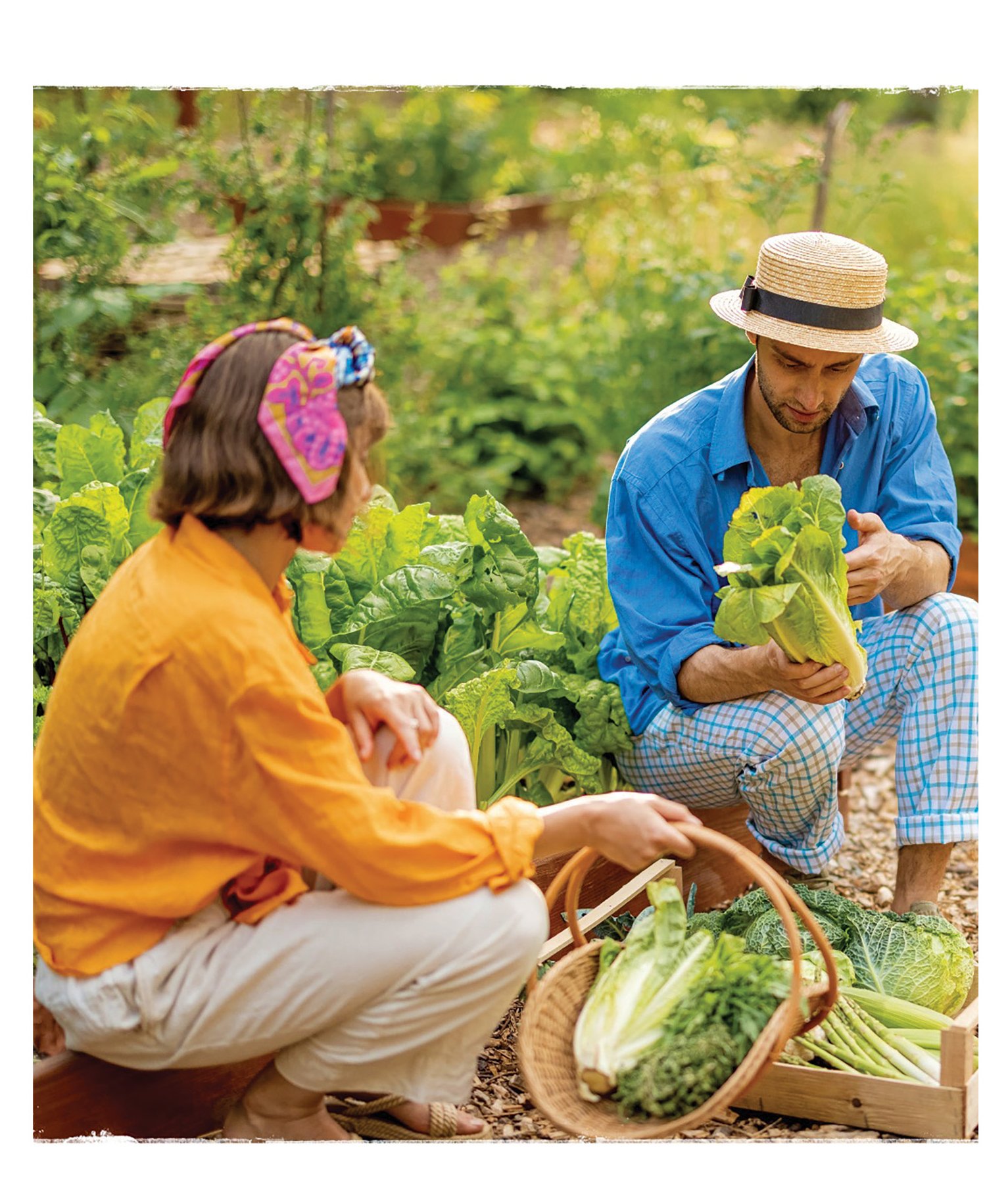By S. K. Rosina Newton
Over the past six months, we’ve witnessed the transformation from last winter’s dormancy into a lush and verdant summer. We’ve been enjoying the fruits of Nature’s labors—beauty, food, and shade from flowers, vegetables, and trees.
Now is the time in our cycle when all this foliar production returns to earth. What has increased must decrease. For leafy life to begin anew next spring, all this green must become brown and nourish the soil.
Why is it that so many of us persist in thinking that autumn is a sad season? Nature has merely fallen asleep, and her dreams must be beautiful if we are to judge by her countenance.
—Samuel Taylor Coleridge
There are many fall gardening to-do lists out there. This one aims to bring a new perspective to the get-ready-for-winter action list!
Focus on the Soil
Over the many decades I’ve had my hands in the dirt, scientific understanding of ecology has evolved tremendously, while horticultural practices still lag far behind.
One of the most exciting concepts is how we can help to reverse climate change, simply by growing our plants in healthy organic soil and by following a few key principles. As we know, plants absorb carbon dioxide from the atmosphere, putting it back into the soil. This reduces the excess atmospheric carbon produced from fossil fuels, but only if our gardening practices support the process. Here’s how we can do our part this autumn to benefit our yard and reduce our carbon footprint.
First, halt the use of all chemical fertilizers and pesticides, if you haven’t done so already. Besides other documented dangers, one way these synthetic products contribute to climate change is by harming soil microbial life. A living soil is essential to plant health and to sequestering carbon. That diversity of invisible soil-dwelling critters processes the incoming carbon and keeps it in the soil and out of the air. Thanks, fungus! Thank you, bacteria!
Second, add high-quality compost to as much of your soil as your budget and energy allow. Studies show that adding just a thin layer of compost allows the soil to absorb more atmospheric carbon, making your yard a carbon-sequestering superstar! Of course, what’s good for our environment is good for plants and vice versa. Compost adds more microbial life along with organic matter and nutrients. It’s also food for the microbes. Compost is one of the greatest garden investments. It may provide all the nutrition your trees, shrubs, lawn, and perennials need this time of year to tuck them in for the winter.
Your own homemade compost can help, but it is rarely enough for an entire yard. Last spring, I ordered 12 cubic yards of compost from Tuthill Farms in South Lyon. It is a family farm from the 1800s! (They sell bagged compost, too). I’ve also heard really good things about Midtown Composting in Detroit. This company is a real environmental mensch. They go door-to-door to pick up compostables, providing a convenient service, and reducing usable “waste” going to the landfill. If neither of these is your cup of compost tea, choose a high-quality compost from your local nursery. Two bagged composts I’ve tested in my garden this year are Master Nursery Bumper Crop Organic Soil Builder and Malibu Compost Bu’s Blend Biodynamic Compost.
A word of caution: Unfortunately, manure and mushroom composts often contain persistent herbicides such as clopyralid. Use one of the composts above or test a sample of new compost by growing beans in a mixture of compost and soil. If they grow distorted, the compost likely contains herbicide residue.
Next on our list of fall chores to save our environment and our yard: Cover all bare soil, preferably with plants. In the vegetable garden and elsewhere, plant a cover crop. These are quick-growing plants sown specifically to cover, protect, and improve the soil. They prevent weeds, add organic matter and fertility, and feed pollinators when they flower. They’ll be busy absorbing atmospheric carbon to boot! Two examples for fall are clovers and hairy vetch. Plant 2-4 weeks before the first killing frost. (Our average first frost is October 20). Plant a blend for more diversity of benefits, such as the Cover Crop Mix from MIGardener.com. Some plants in the mix will die after a hard freeze, creating a mulch, and others will regrow in the spring.
Read related article: How Your Grandmother Paved the Way for Green Living
The old horticultural recommendation is to rototill the cover crop into the soil in the spring. However, tilling does great harm to our soil, reversing the good work we’ve done. Pulverizing the soil breaks up the magnificent strands of fungal hyphae that support plant life and absorb atmospheric carbon. It destroys soil-dwelling pollinators and other beneficials. Instead of tilling, we can use a method from permaculture called “chop and drop.” At least a month before you need to use the garden, and before the cover crop goes to seed, use a sharp hoe and literally chop the plants down at the soil level. As you chop, this biomass will drop to the ground and become mulch—more organic matter for the soil!
For bare soil areas in the landscape where you don’t want to plant cover crops, consider planting a native perennial groundcover such as Common Cinquefoil (Potentilla simplex) or Wild Strawberry (Fragaria virginiana).
Fertilize?
Although it may seem counterintuitive, fall is an optimum time to fertilize. Think of your plants as bears getting ready to hibernate. By the time you are reading this, we have at least three fewer hours of sunlight since that first day of summer. Plants have detected this too, and they have begun storing nutrients in their roots for the winter. You may need to supply some of these nutrients.
Michigan State University recommends fertilizing lawns in mid-September with a slow-release fertilizer. Organic, dry fertilizers are slow release by nature: they depend on the microorganisms in the soil to slowly transform their nutrients into a form the plant can absorb.
This is how Mother Nature fertilizes. In the untamed areas of our Earth, no human is there (I hope!) with a bag of 10-10-10 fertilizer to maintain the plants. Instead, leaves fall, plants and animals die, animals defecate, and all this is decomposed by microorganisms into fertilizer for the plants. That’s why we use compost, and why organic fertilizers contain ingredients such as bone meal and chicken manure. Organic fertilizers mimic nature’s exquisite system. To get the most out of fall fertilizing and avoid waste, apply before early October. The pelletized fertilizer I use for lawn, trees, shrubs, and perennials is Espoma All Season Lawn Food.
If you’ve been fertilizing organically and/or using compost for three years or more, and your plants are looking healthy, your landscape has likely become more naturally self-sustaining. Bravo! You may only need to fertilize trees, shrubs, and perennials this fall at half the recommended rate, if at all.
To Rake or Not to Rake
I can hear your trees now, “I’ve been working hard all summer to produce this rich organic matter for us, and this is the thanks I get? You’re bagging up my leaves and shipping them away?”
Studies show that if tree leaves are mulched into the lawn, they:
Add about 2% Nitrogen fertilizer
Improve soil texture (drainage, water-holding capacity, “sponginess”)
Help prevent weeds
A specific mulching blade kit may be available for your mower.
Meanwhile, are you dreading—or looking forward to—all of the tidying up chores this autumn? Before you get out the leaf rake and loppers, pause for a moment. Consider this, from a Xerces Society article entitled, Put Down Those Pruners: Pollinators Need Your Garden Garbage!
Cut down the stalks and stems bees are nesting in too soon in the spring, or while the bees are settling in for the winter, and its game over for your pollinator pals. Apply a thick layer of wood mulch over the top of ground nesting bees (70% of native bees are ground nesting), or till your garden in spring or fall, and you’ve wiped out your best allies including bees who emerge early in the spring to pollinate….”
Leave the leaves wherever you can. Allow leaves to be your mulch, providing habitat for “salamanders, chipmunks, wood frogs, box turtles, toads, shrews, earthworms, millipedes and many insects species, … (and) many butterfly and moth species, ... such as Luna moths, great spangled fritillaries, woolly bear caterpillars (which become Isabella tiger moths) and red-banded hairstreaks.” Rake leaves wherever you must, to comply with homeowner association rules for example, but keep them as composting material and/or mulch for your beds. Meanwhile, share Xerces Society information with your neighbors and Homeowners Association. All of us play a part in helping horticulture evolve past harming our ecosystem.
More about Lawns and Beyond
If you’re getting compost for the rest of your yard, get some for the lawn too. Add a sprinkling across the lawn—less than a half inch. Compost microbes help decompose thatch and those mulched leaves.
Make sure you are mowing high. Let grass grow to at least four inches before mowing down no shorter than three inches. As Jeff Copeland of A-1 Organic Lawns says, grass blades are the “solar panel of the plant.” Scalp the lawn or mow too short, and you’re removing the “business end” of the plant. You’re also exposing more soil to sunlight, drying out turf, damaging soil, and promoting weeds. Grass becomes stressed, becoming more susceptible to diseases and pests. Increase the lawn’s solar energy inputs this fall, storing them in roots for winter.
Design for Diversity
The dormant season is a time to think about maximizing your yard’s ecological services. First, assess just how much lawn is needed. Lawn is great for walking barefoot and for kids and dogs to play on. However, the lawn is “an ecological dead-zone,” as Xerces calls it. It supports very little—if any—diversity of life. Plan new spring planting areas to replace the lawn—woodland gardens in the shade or vegetable, herb, or pollinator gardens in the sun. In these areas, scalp the lawn now, and add compost and mulch; this will reduce your efforts in spring.
Plant more native trees now, being mindful of their maximum size. If you don’t have some already growing, throw white clover seeds in the lawn. Their flowers—along with dandelions—are one of the first nectar sources for hungry bees in early spring. You can find white clover seeds at MIgardener.com.
Enjoy the Season!
With all the extra time you’ll have by not raking, pruning, and tidying up, there’s more time to enjoy this annual transformation. Take a hike and get some design inspiration. Share the beauty of life in nature with a young person. Make a big mug of your favorite hot beverage and make art of any kind—poetry, song, or cooking. Share the bounty of your garden and yourself with others.
Rosina Newton is an organic gardening coach, speaker, and landscape designer. She has planted trees and taught children and adults in Texas, New York, and now Michigan. Find out more at newearthhomeandgarden.com.
































































































































































































As a gardener, and a general nature romantic, my heart begins to feel torn around mid-February. On one half, I want to honor the last of winter’s deep rest and on the other half, there is the burgeoning energy of spring’s return. One of my favorite activities at this time is to thumb through my seed stores, as well as the new year’s seed catalogs, and begin to plan my garden in earnest.